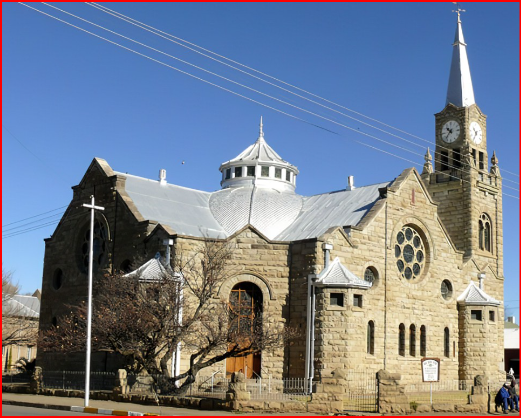
The Merino sheep-farming Town of Burgersdorp, in the North Eastern Cape has been a pivotal point in Afrikaner: History; Culture and Religion. Many Towns in South Africa are named after one person, but Burgersdorp was aptly named after many people: all its inhabitants, in fact. "The Afrikaans farming community where known as: "Burgers". 'Town of Citizens' is what Burgersdorp means.
The being oldest Town in the North-Eastern Cape, it was founded on the Farm Klipfontein in 1846. The inhabitants became the envy of other Karoo Towns because, being sheltered in a Valley below the Stormberg Mountains, there was a milder climate and had access to their own water from the Stormberg Spruit.
The migrant families who first came here were granted permission by the Dutch Reformed Presbytery in Graaff-Reinet to establish a Church of their own. The Town's most imposing symbol is its Dutch Reformed Church. Started in 1912, it is a splendid Building of dressed sandstone, which boasts a huge steeple and clock tower, and a large silver dome and cupola.
In 1860, parishioners who had left the Dutch Reformed Church helped start a new denomination, the Gereformeerde Kerk (Reformed Church'). They invited the Reverend Dirk Postma, from Rustenburg, to start a congregation. Nine years later Postma established a seminary too. Housed in an Outbuilding behind the Parsonage in Piet Retief Street, this became the Theological Seminary of the Reformed Church in South Africa.
The first lecturer of the initial five students was Jan Lion-Cachet, whose belongings are today on view in the old Seminary, which has been turned into a Museum.
In 1905 the Seminary was moved to Potchefstroom, where it later became: 'the Potchefstroom University for Christian Higher Education'. Dominee Postma, a passionate encourager that 'Christian National Education' be taught in South African Schools. Burgersdorp also became the centre of a strong movement to have Dutch recognised as an official language.
The Town also contains a remarkable piece of sculpture dedicated to their erstwhile foe, Queen Victoria. It consists of a very ornate drinking fountain of 1897 to celebrate her Diamond Jubilee. Surrounded by a crown, this spectacular work of art has a lacework dome supported by eight columns, the fountain itself consists of a stork poised over an urn from which water flows. Salamanders crawl up the central column and other storks and doves peep out from the canopy.
Congresses of the 'Afrikanerbond' were held in Town and in 1882, after 25 years of demanding that their language be recognised, they achieved this aim. To commemorate their victory, a 'Taalmonument'-(Language Monument) was erected. Money was collected from around the Country and the Monument was unveiled in 1893. The statue depicts a woman pointing her finger at a tablet held in her other hand. The main inscription reads, De Overwinning de Hollandsche Taal ('The Triumph of the Dutch Language'). Badly damaged during the Anglo-Boer War, Lord Milner had it removed. A replica was made and erected in 1907, but the original - missing its head and one arm - turned up in a King William's Town workyard in 1939. Now the two statues stand side by side in Burger Square. There is also a Memorial to Townsfolk who died during the Anglo-Boer War.
A Monument was unveiled in 1908, by the Afrikaner hero, General Koos de la Rey. To remember the battle that took place near Burgersdorp, in late 1899. This was the 'Battle of Stormberg'. Along with two other battles at the same time in which the British suffered defeat - Colenso and Magersfontein- Stormberg contributed to what became known as 'Black Week'. In the Battle of Stormberg, a Commando of 400 Boers fought a much larger British force and subsequently took possession of Burgersdorp. Four months later, however, the Town was re-occupied by the British and many of the rebels were incarcerated in the Old Jail, built in 1861.
Overlooking the Town from the North, a blockhouse called Brandwag (sentinel) - one in a line of forts that Lord Kitchener had built across the Cape frontier towards the end of the war. It's similar in style to those at Wellington and Laingsburg - together they formed part of a line of Forts that extended from Queenstown, via Molteno and Burgersdorp, to Bethulie. The 'Old Town Jail', in which Piet Klopper, one the first 'rebels' of the Cape Colony, was executed. (This can be visited in an Historical Tour!)